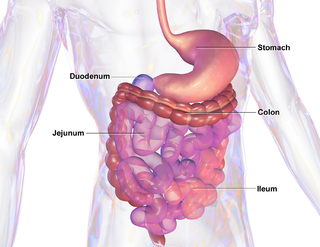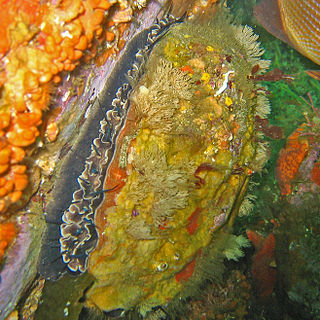Related Research Articles

Abalone is a common name for any small to very large marine gastropod mollusc in the family Haliotidae, which once contained six genera but now contains only one genus, Haliotis. Other common names are ear shells, sea ears, and, now rarely, muttonfish or muttonshells in parts of Australia, ormer in the United Kingdom, perlemoen in South Africa, and pāua in New Zealand. The number of abalone species recognized worldwide ranges between 30 and 130 with over 230 species-level taxa described. The most comprehensive treatment of the family considers 56 species valid, with 18 additional subspecies.

Defecation follows digestion, and is a necessary process by which organisms eliminate a solid, semisolid, or liquid waste material known as feces from the digestive tract via the anus or cloaca. The act has a variety of names ranging from the common, like pooping or crapping, to the technical, e.g. bowel movement, to the obscene (shitting), to the euphemistic, to the juvenile. The topic, usually avoided in polite company, can become the basis for some potty humor.

Myalgia or muscle pain is a painful sensation evolving from muscle tissue. It is a symptom of many diseases. The most common cause of acute myalgia is the overuse of a muscle or group of muscles; another likely cause is viral infection, especially when there has been no injury.
Heartburn, also known as pyrosis, cardialgia or acid indigestion, is a burning sensation in the central chest or upper central abdomen. Heartburn is usually due to regurgitation of gastric acid into the esophagus. It is the major symptom of gastroesophageal reflux disease (GERD).

Irritable bowel syndrome (IBS) is a functional gastrointestinal disorder characterized by a group of symptoms that commonly include abdominal pain, abdominal bloating and changes in the consistency of bowel movements. These symptoms may occur over a long time, sometimes for years. IBS can negatively affect quality of life and may result in missed school or work or reduced productivity at work. Disorders such as anxiety, major depression, and chronic fatigue syndrome are common among people with IBS.

Haliotis cracherodii, the black abalone, is a species of large edible sea snail, a marine gastropod mollusk in the family Haliotidae, the abalone.

Walter Clement Alvarez was an American physician of Spanish descent. He authored several dozen books on medicine, and wrote introductions and forewords for many others.

Gastrointestinal diseases refer to diseases involving the gastrointestinal tract, namely the esophagus, stomach, small intestine, large intestine and rectum; and the accessory organs of digestion, the liver, gallbladder, and pancreas.

Short bowel syndrome is a rare malabsorption disorder caused by a lack of functional small intestine. The primary symptom is diarrhea, which can result in dehydration, malnutrition, and weight loss. Other symptoms may include bloating, heartburn, feeling tired, lactose intolerance, and foul-smelling stool. Complications can include anemia and kidney stones.

Duodenal cancer is a cancer in the first section of the small intestine known as the duodenum. Cancer of the duodenum is relatively rare compared to stomach cancer and colorectal cancer. Its histology is usually adenocarcinoma.
Abdominal bloating is a short-term disease that affects the gastrointestinal tract. Bloating is generally characterized by an excess buildup of gas, air or fluids in the stomach. A person may have feelings of tightness, pressure or fullness in the stomach; it may or may not be accompanied by a visibly distended abdomen. Bloating can affect anyone of any age range and is usually self-diagnosed, in most cases does not require serious medical attention or treatment. Although this term is usually used interchangeably with abdominal distension, these symptoms probably have different pathophysiological processes, which are not fully understood.

Abdominal distension occurs when substances, such as air (gas) or fluid, accumulate in the abdomen causing its expansion. It is typically a symptom of an underlying disease or dysfunction in the body, rather than an illness in its own right. People with this condition often describe it as "feeling bloated". Affected people often experience a sensation of fullness, abdominal pressure, and sometimes nausea, pain, or cramping. In the most extreme cases, upward pressure on the diaphragm and lungs can also cause shortness of breath. Through a variety of causes, bloating is most commonly due to buildup of gas in the stomach, small intestine, or colon. The pressure sensation is often relieved, or at least lessened, by belching or flatulence. Medications that settle gas in the stomach and intestines are also commonly used to treat the discomfort and lessen the abdominal distension.
Pancreatic diseases are diseases that affect the pancreas, an organ in most vertebrates and in humans and other mammals located in the abdomen. The pancreas plays a role in the digestive and endocrine system, producing enzymes which aid the digestion process and the hormone insulin, which regulates blood sugar levels. The most common pancreatic disease is pancreatitis, an inflammation of the pancreas which could come in acute or chronic form. Other pancreatic diseases include diabetes mellitus, exocrine pancreatic insufficiency, cystic fibrosis, pseudocysts, cysts, congenital malformations, tumors including pancreatic cancer, and hemosuccus pancreaticus.

Cronkhite–Canada syndrome is a rare syndrome characterized by multiple polyps of the digestive tract. It is sporadic, and it is currently considered acquired and idiopathic.

Haliotis rufescens is a species of very large edible sea snail in the family Haliotidae, the abalone, ormers (British) or pāua. It is distributed from British Columbia, Canada, to Baja California, Mexico. It is most common in the southern half of its range.

The pink abalone, scientific name Haliotis corrugata, is a species of large edible sea snail, a marine gastropod mollusk in the family Haliotidae, the abalone.
Haplosporidium is a genus in the order Haplosporida.

Haliotis fulgens, commonly called the green abalone, is a species of large sea snail, a marine gastropod mollusc in the family Haliotidae, the abalone. The shell of this species is usually brown, and is marked with many low, flat-topped ribs which run parallel to the five to seven open respiratory pores that are elevated above the shell's surface. The inside of the shell is an iridescent blue and green.

Abalone shriveling syndrome-associated virus was described in 2010 from an abalone which had died from abalone shriveling syndrome.

Haliotis, common name abalone, is the only genus in the family Haliotidae.
References
- 1 2 3 Government of Canada, Fisheries and Oceans Canada (2023-12-19). "Withering Syndrome of Abalone". www.dfo-mpo.gc.ca. Retrieved 2024-01-11.
- 1 2 Crosson, Lisa M.; Wight, Nate; VanBlaricom, Glenn R.; Kiryu, Ikunari; Moore, James D.; Friedman, Carolyn S. (2014-04-03). "Abalone withering syndrome: distribution, impacts, current diagnostic methods and new findings". Diseases of Aquatic Organisms. 108 (3): 261–270. doi:10.3354/dao02713. ISSN 0177-5103. PMID 24695239.